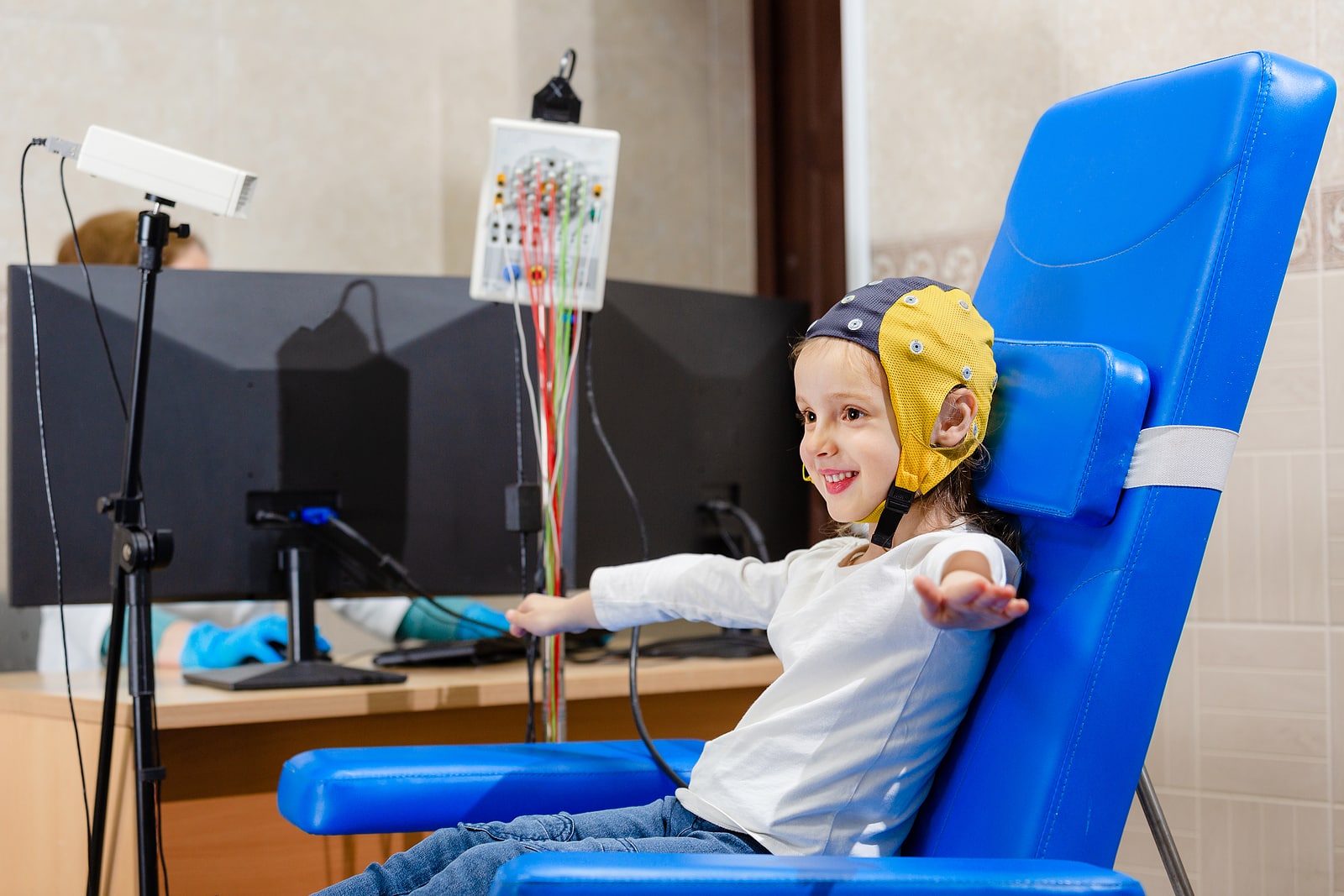Neurofeedback, also known as EEG biofeedback or neurotherapy, is a non-invasive, safe, and painless method of “training one’s brain” to match the structure of a neurotypically developing individual through electrical feedback in the brain (neurodevelopmental center, n.d.).
Unlike other brain-based therapies, there is no electrical current or stimulation of the brain (Chandra, n.d.).
How it works
Through the use of computer-assisted EEG mapping, the outermost layer of the brain called the cortex, which is responsible for the higher, important functions such as thinking, deciding, and acting, is scanned and the electrical activity in each area is visually displayed (neurodevelopmental center, n.d.). The electrical activity will show areas in which there is either too little or too much activity- these will become the areas targeted for change.
Research has repeatedly demonstrated the concept of neuroplasticity, meaning the brain can change and adapt to new information and stimuli over time through the manipulation of brain waves (Chandra, n.d.). Those who suffer from anxiety may experience faster brain waves that result in hyper-aroused, panicky, or feelings of being on edge (Chandra, n.d.)
Alpha waves have correlation with peacefulness, readiness, meditation, and deep relaxation and are therefore targeted to treat conditions such as depression and anxiety (Silva, 2022). Another type of brainwave, the beta brainwave, is associated with focus, sustained attention, tension, alertness, and excitement (Silva, 2022). Individuals diagnosed with a condition such as ADHD may have demonstrated slower brain waves, leading them to feel symptoms such as being in a “fog”, daydreaming, and having trouble with focus (Chandra, n.d.). As such, beta brainwaves are targeted to help symptoms of ADHD (Chandra, n.d.).
At a neurofeedback appointment, patients will have painless electrodes positioned and stuck to their heads to record brain wave activity and patterns. The individual remains awake, with no medication provided, and they are able to walk out of session directly after it ends without any side effects from the procedure.
Sessions last 30-60 minutes and the number of sessions will depend on the individual and the goals made between themselves and their clinician. Many neurofeedback clinic websites suggest starting with 20-22 neurofeedback therapy sessions.

Types of neurofeedback
- Amplitude training – the most common, simplest type of neurofeedback, amplitude training involves using 2-4 electrodes to detect frequencies correlated with conditions such as ADHD, insomnia, or anxiety (Loggins, 2021). Treatment then consists of increasing or decreasing the size of certain types of brainwaves (Silva, 2022)
- Slow cortical training (ILF, ISF, and SCP) – focuses on those brainwaves that move the slowest and through training of these slow brainwaves, individuals can be helped with emotional regulation and brain stabilization (Silva, 2022). Used for individuals with conditions such as epilepsy, migraines, and ADHD (Loggins, 2021).
- Z-score training – training of the brainwaves to be most like the average of those neurotypical peers (Silva, 2022)
- Low-Energy Neurofeedback System (LENS)- targets those individuals with lower energy / slower brain wave activity. This type of neurofeedback requires no conscious effort from the individual and the electrodes on their head emit a very low magnetic field frequencies that help change brain functions, over time (Loggins, 2021). Best used for individuals facing insomnia, fibromyalgia, restless legs syndrome, anxiety, depression, and anger (Loggins, 2021).
- Hemoencephalographic (HEG) – used to help those who experience frequent, painful migraines in effort to target blood flow areas to reduce pain (Loggins, 2021).
- Low-Resolution Electromagnetic Tomography (LORE-TA) – makes use of 19 electrodes and is most frequently used to better understand the brain activity in patients with addiction (Loggins, 2021).
- Functional magnetic resonance imaging (fMRI) – the most commonly used type of neurofeedback and involves the use of electrodes to “map out” brain activity (Loggins, 2021).
Who it helps
Neurofeedback has been scientifically proven to help the symptoms of those individuals who have been diagnosed with
- Autism Spectrum Disorder (ASD)
- Addiction
- Migraines
- Attention Deficit Hyperactivity Disorder (ADHD)
- Pervasive Developmental Disorder (PDD)
- Chronic pain disorders
- Anxiety and Depression
- Epilepsy and other seizure disorders
- Behavior disorders
- Cognitive loss related to age
- Insomnia
- Obsessive Compulsive Disorder (OCD)
- Post-Traumatic Stress Disorder (PTSD)
- Panic disorders
- Traumatic Brain Injury (TBI)
- Stroke
- Tinnitus
- Parkinson’s Disease
How it helps individuals with autism
Neurofeedback can aid substantially with several common symptoms of autism spectrum disorder. Specifically, neurofeedback therapy can help with:
- Stereotypy, or “stimming”– individuals with autism often make use of repetitive movements of their extremities in order to help process overwhelming or uncomfortable stimuli. Neurofeedback can target the area that causes an overresponse to this type of stimuli and train the brain to become calmer (Advanced Neurotherapy, 2020).
- Emotional outbursts, similar to stimming, are typically in response to upsetting, uncomfortable, or anxiety-provoking stimuli. Neurofeedback can help the individual to feel calmer overall, reducing tantrums and other emotionally charged meltdowns and learning to better cope with anxiety (Advanced Neurotherapy, 2020).
- Resistance to change/transitions– another common characteristic of individuals with autism, change or transitions are often extremely difficult and can lead to emotional responses, such as tantrums or aggression. Neurofeedback can help train the brain to react calmly and appropriately to change or surprises in the environment (Advanced Neurotherapy, 2020).
- Hyperactivity and impulsivity are other key symptoms rooted in an autism diagnosis. Neurofeedback can target these areas that sometimes stem from anxiety and help the individual to feel calmer and better equipped to handle stress, thus reducing hyperactive and impulsive behaviors (Advanced Neurotherapy, 2020).
- Difficulty following/taking directions from adults is often displayed in individuals with autism. Directions can seem overwhelming or provoke anxiety, so the use of neurofeedback to target those areas and allowing the individual to feel calmer will help them feel better equipped to take direction (Advanced Neurotherapy, 2020).
Case studies- Autism & Neurofeedback
A study done by Kouijzer, et al., in 2010 sought to further current neurofeedback research by studying the effects of neurofeedback on 7 children with autism spectrum disorder and 7 waitlisted children in a control group, who did not receive neurofeedback therapy. There was a positive correlation with the neurofeedback the children with ASD received to their improvement in the areas of behavior, cognition, and neurophysiology (Kouijzer, et al., 2010).
Another study was focused on a type of neurofeedback using sensorimotor, mu-based neurofeedback training on a group of 17 children with ASD in comparison with 11 typically developing students. As hypothesized, outcomes of the study using mu-rhythm frequency demonstrated a positive correlation, or reduction in behavioral symptoms, between mu-based neurofeedback training in children with mild ASD (Datko, 2018).
In a group of 13 children diagnosed with autism spectrum disorder, pre and post tests were conducted after 16 neurofeedback training sessions (Friedrich, et al., 2015). After the neurofeedback training was completed, the post-test results demonstrated significant improvement in autistic symptoms, social responsiveness, and adaptive behavior (Friedrich, et al., 2015).
Research over the past 20 years has continuously demonstrated positive outcomes and improvements in symptoms for various individuals diagnosed with varying conditions. Limitations have been discussed to address the fact that most studies regarding neurofeedback and autism were conducted with very small control groups. Despite this limitation, neurofeedback therapy has been suggested as an alternative autism treatment for those diagnosed with autism spectrum disorder.
Side effects of neurofeedback
While many people do not report having any side effects from neurofeedback therapy sessions, it is important to note the ones that have been recounted by some participants (Chandra, n.d.). Potential side effects of neurofeedback include:
- difficulty falling asleep
- inattention
- irritability
- sadness
- restlessness
- headaches
Neurofeedback Therapy providers
There are several components of a credible, reliable neurofeedback clinic. Clinics should possess credentials from the Biofeedback Certification International Alliance (BCIA) and/or the Othmer method certification. These organizations offer specific training on neurofeedback and will present a certificate of this training upon completion.
Staff at a neurofeedback clinic should be trained professionals within the field, such as a psychologist, psychiatrist, or neurologist. The clinic’s neurofeedback systems should have obtained FDA approval.




